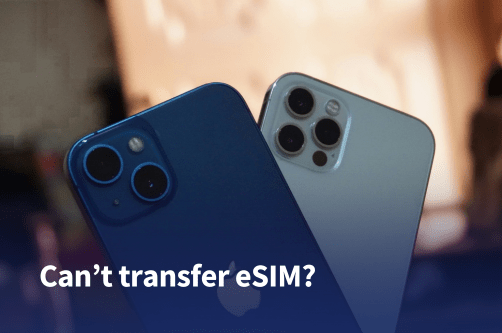Visit the land of reggae and crystalline beaches with the best internet at the best price. We will t...
eSIM Cards
If you can’t transfer your phone number to a new iPhone using eSIM, don’t panic. This issue is common and often easy to fix. In this guide, we explain why the transfer might fail, how to troubleshoot the problem, and what steps to take to get your number working again: whether it’s updating software, re-scanning a QR code, or requesting a new eSIM from your carrier.


If you can’t transfer your phone number to eSIM when setting up a new iPhone, you won’t be able to use the same number on your new device. Thankfully, the problem is usually fixable, and there are several steps you can take to resolve it.
One common reason you might not be able to transfer your eSIM is a mismatch between the carrier settings and the activation process. Make sure your carrier supports eSIM transfers, and verify that your number is active on the new device. Restarting your phone may also help resolve any temporary glitches.
If you’re still facing issues after trying these steps, don’t worry–there will be a solution. In this guide, we’ll cover all the easiest fixes for you to solve the issue. First, you should understand some of the causes.
If you’re having trouble transferring your phone number, there could be several reasons behind the issue.
If you’re still unable to transfer your phone number to an international eSIM after checking these factors, your best option is to reach out to your carrier’s customer support. Here are some more common fixes.
There are several easy troubleshooting steps you can take before dealing with customer support. It’s worth trying them all before taking more drastic action.
One of the easiest fixes is to restart your phone. A reboot can clear any temporary system glitches that might be preventing eSIM transfer. It will also refresh your network connections and help the phone recognize new eSIM activation requests.
On an iPhone:
On an Android:
An outdated operating system can cause compatibility issues with eSIM activation. Keeping your phone updated ensures you have the latest bug fixes and carrier settings, ensuring your device supports the latest eSIM transfer protocols.
On an iPhone:
On Android:
Not all devices support eSIM, and even if yours does, it might not support all carrier eSIM services. Checking is a simple process, and it verifies whether your phone supports eSIM technology before you waste time troubleshooting.
You can check by following these steps:
Alternatively, dial *#06# and check if an EID number appears.
If your phone isn’t eSIM-compatible, you’ll need to upgrade to a new model to transfer your number.
If scanning the QR code doesn’t work, manually entering your eSIM details might help. This avoids any errors from an unreadable or expired QR code, and it ensures precise input of activation credentials.
You can manually enter the details by following these steps:
If your eSIM is already installed but not working, removing and reinstalling it can resolve the issue. This clears potential corruption in the eSIM profile and resets carrier authentication for a fresh activation attempt.
Here’s what to do:
Some carriers don’t support eSIM transfers, or your plan may not be eligible for eSIM activation. This will confirm that your carrier allows eSIM transfers and ensures your plan is compatible.
You can check by visiting your carrier’s official website or contacting customer support. If your plan doesn’t support eSIM, ask if an upgrade is required.
Some VPNs and security apps interfere with eSIM activation by blocking carrier authentication requests, Disabling them ensures your carrier can communicate with your phone during activation.
This is how to disable VPN:
If your phone is struggling to connect to mobile data or WiFi during eSIM activation, resetting network settings can help. This clears incorrect network configurations and resets carrier and WiFi settings to default.
On an iPhone:
On an Android:
NOTE: This will erase all saved WiFi passwords, Bluetooth connections, and VPN configurations.
Switching Airplane Mode on and off can force your phone to reconnect to the network, refreshing the eSIM activation process. You’ll need to leave Airplane Mode on for a few minutes. Follow these steps:
If your eSIM activation is still failing, the QR code may be expired or already used. Getting a new code provides a fresh activation link and prevents these issues.
You can get a new code by visiting your carrier’s website or mobile app. Look for the eSIM activation section or ask someone via live chat.
Once your carrier sends a new QR code, you can follow the usual activation steps to activate the eSIM.
If all else fails, a factory reset might be necessary. This erases all data and settings, giving you a fresh start. It clears system-level glitches and essentially puts your phone in a clean state for activation. However, it also restores your phone to factory settings, so you may lose personal data.
Make sure your phone is fully backed up before following these steps.
On an iPhone:
On an Android:
Usually, transferring your phone number is a straightforward process. If you’re using a physical SIM card, all you need to do is take it out of the old phone and insert it into the new one. But if you’re using an eSIM, there are a few more steps.
Here’s how to do it on an iPhone and an Android.
Transferring your phone number to a new iPhone
Transferring your phone number to a new Android device
The time required to transfer a phone number to eSIM depends on your carrier. In most cases, the process takes a few minutes to an hour if you’re using Quick Transfer on an iPhone. If you need to request a new eSIM from your carrier, it could take up to 24 hours.
No, your phone number is tied to your carrier account, not the device itself. If you’re unable to transfer your eSIM, you won’t lose your number. Instead, you can request a new eSIM from your carrier or revert to a physical SIM (if supported). However, it’s essential to resolve transfer issues promptly to avoid service disruptions.
Yes, in some cases it’s possible to transfer your number without contacting your carrier. With eSIM Quick Transfer (for iPhone) or carrier app-based eSIM activation, you may not need to contact your carrier. However, if your carrier requires a new QR code or manual activation, you’ll need to reach out for assistance.
Yes, switching to an eSIM does not change your phone number. When activating eSIM, you simply transfer your existing number to the new digital SIM. As long as your carrier supports number portability, your number will remain the same.

